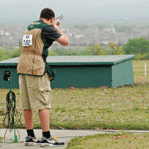The Mason Trap and Skeet Club Team continued the legacy of their historic program last month by winning its 11th National Championship in San Antonio, Texas. It was their first National Championship since 1994.
“It was a big team effort. We did not win any individual honors but as a group we shot really well,” head coach Gary Olin said. “That is why we won six team trophies. It is good to be back on the national stage.”
The program, which started in the early 1980s, is the second oldest club sport at Mason behind only rugby. Legendary coach John Linn led the team to seven consecutive national championships from 1985 – 1992.
Olin, who has been the head coach since 2001, has led the team back to its winning ways and ended their dry spell.
The team had a fair amount of success leading up to the championship, winning a couple of tournaments during the regular season. They won the team high overall among many others in the Eastern Regional Championships that featured over 120 shooters from 12 different schools ranging from Vermont to Virginia. They also won their second consecutive Virginia Own-The-Trophy tournament where they have the honor of traveling with the trophy for a year.
Among their team accolades included many individual titles from sophomores Austin Hall and Renee Murphy. Both are Eastern Regional Champions and improved tremendously from last year. Their near perfect performances at nationals, included a 99 by Hall in trap.
“We work hard all year long and to go down there and not win would be a let down,” said Murphy, who only has two years of shooting experience but already is the woman’s champion in Virginia. “We work so hard for it. We realized that all of our hard work and practicing pays off. We went down with the mindset that we were going to win this year.”
The Trap and Skeet National Championships are very different from other sports because every team qualifies for nationals as long as they can afford it. There are three divisions that are determined by how many shooters a team has.
A program like Mason, which has only eight shooters, is placed in division three. Larger programs like Lindenwood University from Missouri are placed in division one because they brought over 50 shooters and have more larger budget than other schools.
The hardest part and biggest difference in shooting, according the Olin, is not the money or size of the program.
“In some sports if things are going badly, the coach can call a timeout and talk to the players like in basketball and football,” said Olin, whose coaching position is 100% voluntary. “When your team is shooting, you do not get to do that. You just have to stand back and watch them. You have to keep your fingers crossed and hope that they do well. It is hard to be a spectator.”
For the shooters, the toughest part is keeping their head straight even when they miss a target.
“Mental. There are people on our team where if they miss one bird, they are done,” said Hall and Murphy. “They get so frustrated with it. You could hit everything but could also psyche yourself up. Some people just beat themselves up about it.”
The team’s next goal is to build the program and recruit more shooters so they can repeat as champions.
“I think we could be even more successful if we had even more shooters. The coaching is awesome. If you could find yourself doing this and keeping up with it, it is definitely something to look into,” said Hall and Murphy. “You have to try it before you turn it down because it becomes addicting.”
With three shooters graduating, the program is looking for new shooters for both men and women.
STORY BY JAMES ZEMBRISKI

